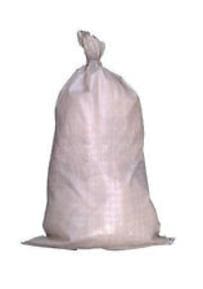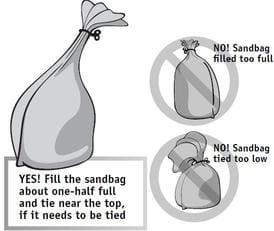EMERGENCY SAND BAGS



Emergency sandbags have long been used to slow down the spread of flood waters to protect people and infrastructure. When used correctly, these sandbags provide an effective barrier just long enough for flood waters to subside or to afford emergency personnel enough time to evacuate those in immediate danger.
To make the most of your sandbags, it's important to know the basics.
What Are Some Common Types of Applications Emergency Sandbags Are Used For?
Emergency sandbags create effective barriers that can withstand some force. This makes them ideal for the following events:
Flooding. Sandbags are added to riverbanks and around properties to create a barrier against water. When correctly packed, they can withstand high currents and force.
Erosion. Erosion occurs along riverbanks and sand dunes and can have a devastating effect on the environment as it shifts water lines, tree lines and sand encroachment. Sand bags form a strong barrier to prevent further encroachment.
Construction site protection. Construction sites have very little protection, especially when roofs and walls haven't been erected yet. This can create a mess when water starts flooding into the site, causing costly downtime in drainage efforts. Sandbags around the lot can prevent the site from flooding.
Ballast. Sandbags are heavy and dense, making them hard to move during rough weather conditions. That makes them effective in weighing down tents, sheeting and other materials during windy conditions.
How to Properly Fill Emergency Sandbags?
How you fill your sandbags can determine whether they will form an effective barrier or not. Here are some tips to ensure you fill your sandbags correctly:
Clean sand and clean sandbags. When you use sand from a riverbed or beach, there could be stones, shells, and other materials in there that can compromise the stability of the bag. For instance, the debris can shift around or rot, causing air pockets that prevent the bags from getting packed together tightly and staying that way. The sandbags also need to be clean to ensure there are no weak spots that may lead to tearing.
Don't overfill the bag. Only fill the bag halfway to ensure a good distribution of sand and to prevent tearing.
Fold over the flap. The bag should only be filled halfway and the remaining fabric on the bag should be folded in underneath to prevent the sand from falling out. This method also ensures that the bags remain as flat as possible.
Stack the bags properly. Whether you're storing the bags for later use or creating a barrier, the pyramid shape is the way to go. It provides a solid base that's unlikely to topple.
Fill in any gaps. Ensure the bags are tightly stacked to prevent possible leaks. Even small gaps can cause water to trickle through and once this starts, is possible that the sandbag wall will collapse.
What Are Some Benefits and Advantages of Using Emergency Sandbags?
Sandbags are ideal in emergency situations, as they provide an effective barrier against sudden situations, such as flash floods. Other benefits include:
Readily available. Sand isn't a scarce commodity, and it's easy to get hands on sand to help create a defensive barrier in emergency situations such as flooding.
Cost-effective. When unexpected flooding happens, there might not always be money available for more permanent solutions such as levees. Sand barriers are cost-effective as a short-term solution for flooding.
Versatile. Sandbags are known for their efficacy in flooding situations but also happen to be helpful on construction and dune protection sites.
Environmentally friendly disposal. It's easy to dispose of sand without creating an environmental hazard, making it the ideal choice for effective emergency barriers to create a trash rack or flood barrier.
What Shouldn't Emergency Sandbags Be Used For?
Sandbags may provide an effective emergency barrier against flooding, but it's a short-term solution.
Sandbags shouldn't be used in the following circumstances:
As a permanent prevention method against flooding
As retainer walls for flooding, such as flood walls, as these may collapse and cause further damage
To create high structures, especially where there is a risk that the bags may collapse on people
How Effective Are Emergency Sandbags Against Flooding?
Sandbags are effective in the short term as an emergency barrier. If long-term flooding is expected, a more permanent flooding solution should be put in place, such as retainer walls and levees.
Gabion Supply provides bulk emergency sandbags for emergency flooding protection. Give us a call to discuss your flooding needs.
Common usage of sand bags:
• Flood control and protection
• Redirect storm and debris flows
• Reinforcing existing dike structures
• Erosion control
• Levee construction
• Providing extra weight for traffic / road signs
• Extra weight for winter traction for pickup trucks or cars
Features:
• White woven polypropylenew/ UV stabilizer
• Attached ties for closing bags
• Hemmed top / folded bottom

Filling Sandbags
Fill the bags about one-half full and do not tie them closed. Untied bags form into the dike better than tied bags. Filling sandbags usually is a two-person operation. One member of the team holds the bag on the ground slightly in front of his or her spread feet and the second shovels the sand into the bag. Use gloves to protect the bag holder's hands. The use of safety goggles is desirable, especially during dry and windy days. For large-scale operations, filling sandbags can be expedited by using bag-holding racks, funnels on the back of dump trucks used for sanding operations and various power loading equipment. However, the special equipment required is not always available during an emergency.
Where do you use sand Bags:
• Flood control and protection
• Redirect storm and debris flows
• Reinforcing existing dike structures
• Erosion control
• Levee construction
• Providing extra weight for traffic / road signs
• Extra weight for winter traction for pickup trucks or carsFeatures of our Sandbags:
• White woven polypropylene
• Attached ties for closing bags
• Hemmed top / folded bottom






